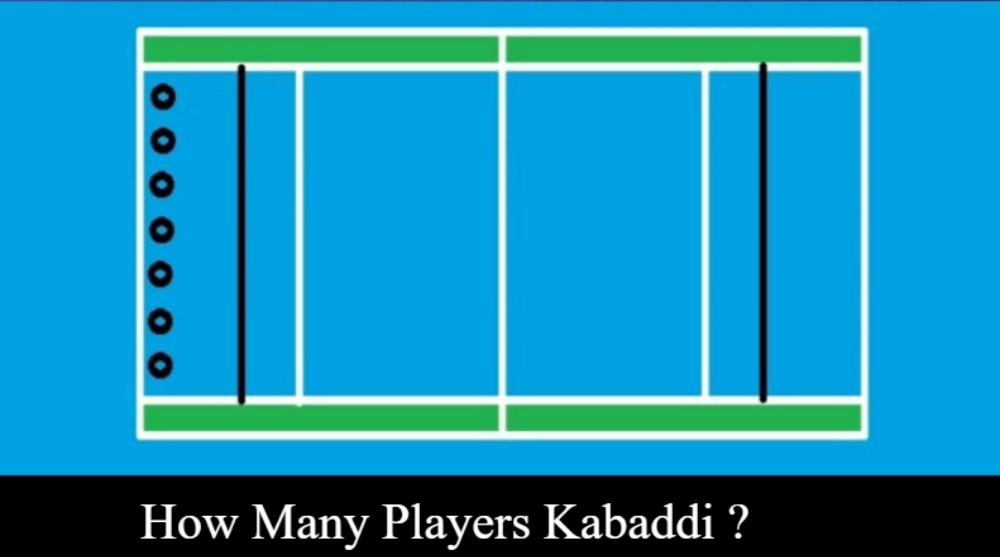Imagine a bright, sun-lit evening in the Deccan plateau Seven athletes kneel like springs coiled on one side of a painting rectangle, their eyes glued to the single raider ready to race into their area of. The crowd, roaring a single word–“Kabaddi!”–falls into a hush so tense you can hear cloth scrape on skin. This is where the geometry meets the gladiator school and the size of the team is the keystone of each tactic. This article will discuss how many players in kabaddi team rosters — why it’s not random, and how various styles alter the rules. The game is extremely popular for locals.
In the past, from the dusty village field to stage lights that make up the Pro Kabaddi League, the game has grown beyond its South Asian roots. But amidst the neon glare the basic mathematical principles remain the same: too few players, and the defense is destroyed with too many players and the court turns into rush-hour Mumbai. So sit back and explore the history of war games to a broadcast spectacle, and attempt to understand why counting up to seven is the very first lesson in Kabaddi literacy.
Kabaddi in a Nutshell
The historians will debate whether Mahabharata’s Abhimanyu was the first to invent the raid but everyone I’ve spoken to swears the sport’s heartbeat isn’t stopped since the time humans ran after each other to get food. Originating in the slums of today’s India, Bangladesh, and Pakistan the sport requires the flat ground and lungs. The rules were established in the 1920s and presented in 1936 at the Berlin Olympics and, finally, became a major draw as it was the Pro Kabaddi League (PKL) was a major draw on Indian TV in 2014.
The game is played with a stunning three-beat pattern: raid, defend and breathe. A raider is able to cross the middle line while chanting “kabaddi” in a single breath, while tagging his defenders with the human stroke. Defenders–stoppers, corners, and covers–swarm to catch him as he scurries back home. Points are awarded for tags and tackles, bonus line sprints, and the spectacular “super tackles” when a Skeleton-crew defense is used to alter the rules. The games are played in just two twenty-minute intervals (PKL prefers four 10-minute quarters) which makes kabaddi the fastest chess game in which exercise meets math in real-time.
How many players in kabaddi team?
If you ask ten casual readers, you’ll get about a dozen responses The rulebook, however, is very clear, provided that you know the chapter you’re currently reading. Let’s look at it in detail.
Official Regulations
World Kabaddi guidelines decree seven active players each side on the court, and five substitutes waiting to be added. The word “seven” is sacred: it combines the offensive range (enough bodies to stop exit angles) as well as defensive weakness (leave gaps and a quick raider moves through).
- Divisions for Women and Men: Player count is similar, however women generally play on a 12m 8 m court as opposed to the men’s 13 10 m x 10 m.
- youth Leagues: Same seven-plus-five basis, however raid clocks may be reduced by 25 seconds to fit smaller lungs.
Pro Kabaddi League Twist
The PKL is a variation of the seven-plus-five format but with a more cosmopolitan twist: each match-day seven will feature at minimum one international player. The tiny change makes it more difficult for coaches to balance international stars and local talent, adding to the tactical pool and broadening the passport stamps of kabaddi.
Casual & School Variations
Backyard kabaddi laughs at strict rosters. Two two. Two in the hallway of a dorm? Absolutely. A PE class split into fives because three children didn’t have shoes? Still kabaddi. The magic lasts for as long as both teams have the same numbers. Once numbers are not matched the fairness of the game. Yes, this is when you’ll hear one person ask, “ how many players are there in kabaddi if we’ve only got six friends?” Answer 3 players per side with plenty of fun. simply shrink the court to suit.
Team-Size Cheat-Sheet
| Format | On-Court Players | Reserves | Total Squad | Notable Quirk |
| Official (World Kabaddi) | 7 | Up to 5 | 12 | Standard layout |
| Pro Kabaddi League | 7 | Up to 5 | 12 | More than 1 player from outside |
| School / Recreational | 2 – 7 | Flexible | 2 – 12 | Adjust to attendance and space |
The Kabaddi Court & Player Roles
Dimensions in Brief
If kabaddi was like a chessboard. The courts would function as the main stage on which warriors are able to are able to move with intention. Similar to chess, the size of the arena affects each decision. In the case of men’s games the battle field is 13 meters in length and 10 meters in width–a perfect rectangle that has a slim gut and sharp edges. Women’s games draw the edges in with twelve by eight meters with plenty of room to dance and dive around in formations.
Why is size important? Because distance equals danger. A longer trip back for the rogue gives them more time to be attacked. However, defensive players must take on more ground, which makes communication and split-second anticipation crucial. Smaller courts can make the game more difficult and can increase the chance of full-body collisions. Combine that with the stress of the fast-moving raid clock, and you’ll have a game that requires both geometry and determination.
Core On-Court Roles
Kabaddi isn’t a mess, but a choreography that comes that is accompanied by bruises. Every single player on the court have specific roles, and when every cog works together and the result is the ultimate in timing.
Here’s an overview of the first seven
- Raider The lone wolf who infiltrates territory of the enemy. His goal? Tag and then retreat. Imagine a striker from football with the lung capacity of an athlete who runs.
- Left Corner – Anchored at the left-bottom corner this player is skilled with ankle holds. The player is low, deadly and lightning-fast.
- Right Corner Mirror image at the opposite end. A dash specialist who is able to time the charge as a sprinter from the blocks.
- Left Cover and Right Cover Midcourt positioned These two players are central stoppers, typically assigned to lead the tackle or securing the line.
- Left In and Right In – Floaters either side are ready to join forces to tackle or fill any gaps that pop up. These players are courts’ Swiss Army knifes.
When there are 7 players moving the coordination of players is paramount. In the event that you move even one position out of order then the defense wall is an unintentional leaky bucket.
Rules, Scoring & Substitutions
The fundamentals of kabaddi’s mechanics. Raids are for up to 30 minutes and, within that time the player must cross the enemy line, tag as many enemies as he can and then return safe. But there’s a catch: the raider must be able to chant “kabaddi, kabaddi” without stopping for breath. If he doesn’t chant, he’s not awarded points, and probably an award to the defense.
In the meantime, defense personnel can take on the rogue, but not with his hair or clothes. If they are able to stop him before he makes his way back across the line of mid-line the team earns points and have the possibility of sending him away. This is where the size of the team is an issue when a defense that is full of seven can create a maze of traps and if only three players remain? Risky, but high reward – cue”super tackle. “super tackle.”
Revival is a different jewel in the kabaddi crown. Every time a team wins they are able to return any of the “out” players. Substitutions are also permitted but only during the downtime between raids, and not as substitutes for players who are ruled out during the game.
Quick-Fire Scoring Facts
Let’s look at the scoreboard in the native language of Kabaddi:
- Tag touch: 1 point per defender tagged
- Cross-line bonus (with more than 6 defenders present): 1 bonus point
- Resolving a raider 1 point for each successful hold
- Super tackle (with 3 or less defenses): 2 points
- Lona (wiping out the entire team): 2 bonus points
- Technical infractions (late chant or out-of-order raids, etc. ):
In kabaddi math meets muscles. With fewer opponents each point is a chance to play the dice.
Strategy Spotlight
The management of the management of a 12 player squad (7 active and 5 reserve) isn’t just about filling up jerseys, it’s about strategic alchemy. Coaches must be aware of when to put off the star raider, and when to let their defense enforcer loose. In the Pro Kabaddi League’s policy of requiring at least one player from outside the country is an additional layer of different styles, speeds and making decisions.
Rotations are fast. A failed attack could result in the loss of your best player, and getting them back requires patience and a lot of precision. The depth of a team is crucial: a team comprised of only two key players is often ruined during the second half. The secret ingredient? Balance. You require a defender who is able to score when pressure is at its highest as well as defenders who can stop an opponent by using his pinky toe and a substitute who is focused even when being benched.
Conclusion
The game has evolved from village dust to show-stopping glamour, kabaddi is still true to its roots seven warriors, a single breath and the tense walk through chaos, choreography and. No matter if your viewing Pro Kabaddi or scrimmaging with colleagues, knowing the different players in the kabaddi can be the initial step towards unlocking the beauty of its brutality.
There is no equipment required. All you need is grit, game-sense and perhaps the sound of a chant that’s stuck into your throat. Seven is a number but in the kabaddi tradition, it’s a legacy.
FAQ — Fast Answers About Team Size & More
1. How many players participate in the kabaddi official game?
Seven on court, with up to five substitutes, 12 in total.
2. What is the reason why Pro Kabaddi insist on an out of the country player?
To make the sport more global and to introduce different types of play.
3. Are we able to play kabaddi with less than seven players?
Absolutely. School and casual versions usually reduce up to as little as two people per side.
4. What happens when the team is reduced to less than four active players?
It can trigger the “super tackle” condition–if the defense succeeds, they will earn 2 points instead.
5. How often can teams replace players?
Unlimited substitutes between raids but those who have been exiled “out” can only return through revives.
6. Does a raider have the ability to score without tag anyone?
Yes. You can cross the bonus line when the opponent team is comprised of six or more players on the court.
7. Is kabaddi played barefoot?
In traditional formats Yes, in traditional formats. However, Pro Kabaddi and international matches are now allowing soft-soled shoes.
8. Are players able to be sacked by their hair or shirt?
No. Only torso and limb contact is permitted. Hair and clothing are not allowed.


